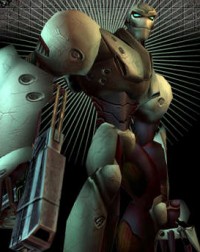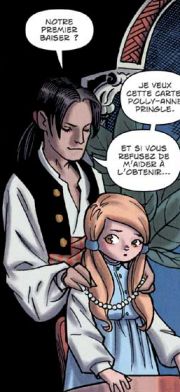Auteurs et autrices / Interview de Ted Naifeh (VO)
Ted Naifeh talks to BDTheque about Courtney, Polly, France, and more generally about his wild, decadent and debauched lifestyle. (Read the french version here)

 Hi Ted, tell us a bit about yourself.
Hi Ted, tell us a bit about yourself.
Like many brilliant spirits, I grew up in a hopeless, soul-crushing middle-class suburb outside a great metropolis, in this case, San Francisco. I started going to school in the city in my early teens, and eventually moved here to better live the wild, decadent, debauched lifestyle of a… um… a comics creator.
Ahem, anyway…
I started drawing professionally in the early nineties. I’d been electrified by Frank Miller’s Dark Knight Returns, as well as a lot of French work trickling in via Heavy Metal Magazine. My early artwork was inspired by Miller, Moebius, Caza and Jon Totleben, who worked with Alan Moore on Swamp Thing and Miracle Man. As a young artist, I aimed high and failed spectacularly.
At that time, Jim Lee, Todd McFarlane and several other flashy marvel artists had just started Image. Money was pouring into the industry. American companies were paying top dollar to kids like myself who barely knew how to hold a pencil. I did incredibly mediocre work for several years, and was just starting to develop some decent skills when the bubble burst and all the jobs dried up. I ended up getting work doing concept design and graphics in videogames. But I couldn’t give up on the dream of creating comics.
Eventually, a friend and I created a rough little comic called Gloomcookie, just for fun. It became hugely popular. I quit games and went back to work doing comics full time, writing and drawing small independent comics like Courtney Crumrin as well as doing the occasional work for hire on things like Star Wars and Death Junior.

 According to your website, one of your interests is travelling. Have you been to France before? Have you attended any French comics festivals?
According to your website, one of your interests is travelling. Have you been to France before? Have you attended any French comics festivals?
I’d been to Paris as a teenager, but that hardly counts. Most of its wonder was lost on me, though I did spend several hours in a comics shop near the Sorbonne.
Since Courtney Crumrin was published, I’ve been three times on signing tours. I went to last year’s Angouleme, and the most recent St. Malo festival. Both were fantastic experiences, and seeing all the new books, and meeting all the amazing artists, watching them work, it’s all thrilling. St. Malo is a gorgeous city, and the gallettes were delicious. I know that some folks aren’t impressed with Angouleme as a city, but I found it utterly charming, especially in the snow. I took dozens of pictures. We Americans don’t have nearly as much cultural heritage lying around. In Angouleme, I got to stay in a little 18th century farmhouse. It was like being in a period movie.
But my favourite part of the tours was appearing in the local shops. I got to see a new city almost every day, sample amazing local cuisines from different regions, and meet hundreds of fans face to face. I’ve been to more cities and met more fans in France than in America.
 Before gaining success in the comics industry, you worked in the videogames industry. Tell us a bit about that.
Before gaining success in the comics industry, you worked in the videogames industry. Tell us a bit about that.
I worked for a company called Accolade. I’d been hired by a friend from art school to work on a giant robot game called Slave Zero. Because we were both of a certain aesthetic bent, the game had a very dark, gothic-industrial flavour, and it was terrific fun to work on.

 Why did you leave the videogames industry? Would you consider working with games again?
Why did you leave the videogames industry? Would you consider working with games again?
There was a great deal of interference from our corporate masters. In Slave Zero, our giant robot, the star of the game, was conceived as a stiletto-heeled, torpedo-breasted biomechanical hybrid of Godzilla and Evangelion. The design was simply delicious. But the CEO demanded that we change it into something that unimaginative teenage boys were more likely to identify with. It eventually morphed into a hulking, brutish cross between iron-man and a gorilla. According to the executives, the gorilla looked more heroic, more like something you’d want to be, rather than something you’d want to kill. The whole experience left me profoundly unsatisfied. I quit the project and worked on a motorcycle racing game, which, despite the fun of building 3-D models of motorcycles (I soon developed a fondness for motorcycles that I’ve never shed), didn’t fulfil me artistically.
Accolade was bought by the French company Infogrames, and I was eventually laid off. I don’t think I’ll ever go back to videogames. I find that the process of game development is too controlled by commerce. And besides, I only have enough time in my life for one career path. I don’t see myself derailing my comics career for the sake of working on a videogame again, no matter how interesting it is.
 And then in 1998 things picked up comics-wise, with the success of Gloomcookie. Tell us a bit more about this project that has only just been published in France.
And then in 1998 things picked up comics-wise, with the success of Gloomcookie. Tell us a bit more about this project that has only just been published in France.
My friend Serena and I cooked up the idea for Gloomcookie while I was working in games. I’d all but given up on comics, but Serena’s short story, titled Lex & Max, about dysfunctional romance in the nightclub world, touched me. It turned out to be a perfect fit in the independent comics world at that time, with books like Johnny the Homicidal Maniac and Lenore bringing a fresh crop of goth readers to comics. There were so many female readers looking for goth material, and not nearly enough comics aimed even vaguely at them. The first issue sold out almost overnight. I couldn’t believe it. I’d spent the first five years of my career doing work for hire, drawing books that publishers placed me on, and getting nowhere. The very first creator-owned comic I put out was a resounding success. I took that as a sign I needed to follow my own instincts, rather than just doing what I was told.
Also, I think with Gloomcookie, what my work lacked in skill it made up for in enthusiasm, and understanding the style. That was part of the benefit of choosing my own material rather than having it assigned to me.
 And then obviously the lovely Courtney came along. What inspired you to create this strong character and rich fantasy world?
And then obviously the lovely Courtney came along. What inspired you to create this strong character and rich fantasy world?
I’d be lying of I said Harry Potter’s existence had nothing to do with the creation of Courtney Crumrin. I wouldn’t say that J. K. Rowling’s work has had a huge influence on mine, but the success of that series indicated to me that children’s work, which I’ve always enjoyed reading, has a large and receptive audience. Also, listening to Harry Potter audio-books got me through many long hours of drawing.
Manga has had less influence on me than one might imagine, looking at my work. I never took much interest in it before the digest sized books started coming along. The long, protracted stories didn’t work in the regular comics format. Now I’m reading more manga, and it’s having an influence. I did watch a fair amount of anime over the years, though, and picked up the art style pretty early. Even as a young teenager, I copied faces out of cine-manga versions of the movie Macross.
 You wrote a spin-off about the youth of Uncle Aloysius, a fascinating character of the story. Was it on fan’s demand? Are other spin-offs planned?
You wrote a spin-off about the youth of Uncle Aloysius, a fascinating character of the story. Was it on fan’s demand? Are other spin-offs planned?
I’d done the Aloysius spin-off purely as a whim, and I plan to do more. One of my favourite things about fantasy stories is the world-building aspect, and I’d like to continue that, fleshing out the history of the Crumrin family and the night things’ mythology. I wish I had time to do more spin-offs right away, but I’m really eager to get back to Courtney herself, as well as some other projects.
 Your most recent project, Polly and the Pirates, is being published in France at the moment. What has inspired you to create this story?
Your most recent project, Polly and the Pirates, is being published in France at the moment. What has inspired you to create this story?
The sudden surge of pirates in pop culture, thanks mostly to Pirates of the Caribbean, really took me by surprise. I’d occasionally seen pirates appear in comics, usually done without much imagination, but just pulled out of mothballs and presented in a self-consciously kitsch way. “Look how kooky pirates are!” I was often struck with the suspicion that the creators of these little underground books wanted to somehow force pirates back into some sort of pop culture relevance, when all I could see was a sort of post-modern hokiness trying to pass itself off as hip.
When Pirates of the Caribbean came along, it was cresting a pop culture wave I never expected to see. Suddenly, pirates are everywhere, in comics, in fashion, in the collective unconscious. I figured that since I was so wrong about them coming back, I might was well try my hand at the genre. I guess that’s probably the silliest reason in the world to write a comic. Oh well.
Also, looking back, I realize now that some of those pirate comics I’d sneered at were pretty fun. And anyway, I had this funny idea for a fantastic version of San Francisco on houseboats.
 The main character is a young girl again… why are you focussing on young female characters?
The main character is a young girl again… why are you focussing on young female characters?
People keep asking me that. I don’t really know the answer. Maybe it’s because there are so few interesting female lead characters in comics, it’s easy to come up with a new approach to a genre simply by thinking, “What if the main character were a girl?”
Polly is sort of a female take on Jim Hawkins, the boy adventurer of Treasure Island. Or perhaps she’s Wendy and Peter Pan combined. I wanted to take what is traditionally a boy’s adventure genre story and make it about a girl. But I didn’t just want to thrust a girl into a boy’s story. I wanted to make it about being a female adventurer, and all the unique aspects of such a role. To me, character and plot are so much a part of each other that they’re practically the same thing. You can’t simply change the character’s gender and expect the plot to follow the exact same path. An adventure for a woman means something different than it does for a man. For one thing, it’s more subversive. All adventures are journeys beyond the borders of society’s laws, but it’s less tolerated for women to cross those boundaries, lest they get dangerous ideas from what they learn beyond the strict rules of society. This, I suppose, is what makes female adventurers so compelling for me. Their adventures are more dangerous, more subversive. They have more to lose, and so, of course, more to gain.

 In France Polly is published in big full-colour format. Have you seen the result? What do you think of it?
In France Polly is published in big full-colour format. Have you seen the result? What do you think of it?
I love the larger books. They feel epic, but at the same time, friendly and warm. The colour is wonderful. As much as I like my little manga-sized edition here in the states, I feel that the black and white doesn’t convey the mood I wanted for Polly’s world. You can see how much colour I myself put into the covers. That’s the feeling I wanted to convey with the book. And I think Albertine (Albertine Ralenti, coloriste de la version française, ndw) captured that feeling beautifully.
On the other hand, I feel that if I had it to do over again, I would prefer to release the books two chapters per volume instead of one. I don’t think the chapters are long enough to leave the readers satisfied.
 I have read on your website that Polly might be adapted to the big screen! Is that still on the cards? How would you feel about it?
I have read on your website that Polly might be adapted to the big screen! Is that still on the cards? How would you feel about it?
That is still in the talking stage, but it looks good. A major film director seems to like it quite a bit. We’ll see what happens. I’ve learned not to hold my breath waiting for things to happen in Hollywood.
 What are your current and future projects? When are we going to read a Courtney story next? What about Polly?
What are your current and future projects? When are we going to read a Courtney story next? What about Polly?
I plan to write and draw two more Polly books eventually. But my next project will be another Courtney story. In fact, I need to wrap this interview up and get back to writing it.
 Thanks a lot Ted!
Thanks a lot Ted!
Thank you!
Site réalisé avec CodeIgniter, jQuery, Bootstrap, fancyBox, Open Iconic, typeahead.js, Google Charts, Google Maps, echo
Copyright © 2001 - 2024 BDTheque | Contact | Les cookies sur le site | Les stats du site
